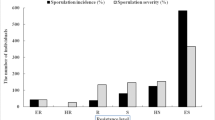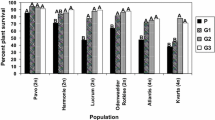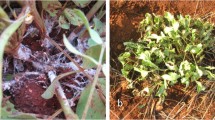Abstract
Sclerotinia crown and stem rot is the most destructive disease on red clover in areas with cool seasons including North America and Europe. An artificial inoculation test in controlled conditions has been developed in order to evaluate resistance to this fungus in individual plants. Measured drops of ascospore suspension were applied to detached clover leaflets and disease severity scored on a visual scale. Clovers from 16 cultivars and 12 ecotypes were tested for resistance to Sclerotinia trifoliorum. The results obtained for cultivar resistance are in agreement with those of other tests described in the literature. Moreover, repeated individual evaluations on detached leaflets from the same plant was successful in detecting genotypic variation within clover populations.
Similar content being viewed by others
References
Arseniuk, E., 1989. Effect of induced autotetraploidy on response to Sclerotinia clover rot in Trifolium pratense L. Plant Breeding 103: 310–318.
Castaño, F., F. Vear & D. Tourvieille de Labrouhe, 1989. Utilisation de plusieurs tests simultanés dans la sélection pour la résistance du tournesol vis-à-vis de Sclerotinia sclerotiorum. Informations techniques du CETIOM 107: 14–20.
Delclos, B. & G. Raynal, 1995. Comparison of techniques for the production of Sclerotinia trifoliorum ascospores in the laboratory for forage legumes resistance tests. Journal of Phytopathology 143: 345–348.
Dijkstra, J., 1964. Inoculation with ascospores of Sclerotinia trifoliorum for detection of clover rot resistant red clover. Euphytica 13: 314–329.
Dixon, G. R. & J. K. Doodson, 1974. Techniques for testing the resistance of red clover cultivars to Sclerotinia trifoliorum Eriks. (clover rot). Euphytica 23: 671–679.
Loveless, A. R., 1951. Observation on the biology of clover rot. Ann. Appl. Biol 38: 642–665.
Marum, P., R. R. Smith & C. R. Grau, 1994. Development of procedures to identify red clover resistant to Sclerotinia trifoliorum. Euphytica 77: 257–261.
Pratt, R. G. & D.E. Rowe, 1991. Differential responses of Alfalfa genotypes to stem inoculations with Sclerotinia sclerotiorum and S. trifoliorum. Plant Disease 75: 188–191.
Raynal, G., 1981a. La sclérotiniose des trèfles et luzernes à Sclerotinia trifoliorum Eriks. I. — Choix d'une méthode de inoculation artificielle. Agronomie 1: 565–572.
Raynal, G., 1981b. La sclerotiniose des trèfles et luzernes à Sclerotinia trifoliorum Eriks. II. — Variabilité du parasite, résistance des plantes en conditions contrôlées. Agronomie 1: 573–578.
Raynal, G., 1983. Production au laboratoire d'apothécies de Sclerotinia trifoliorum Eriks. pour l'évaluation de la résistance du trèfle violet à la sclérotiniose. Agronomie 3: 369–373.
Raynal, G., 1985. Observations sur le comportement variétal au champ du trèfle violet vis-à-vis de la sclérotiniose et sur l'épidémiologie de la maladie. Fourrages 101: 85–104.
Raynal, G., P. Gayraud, C. Mousset-Déclas & A. Serpeille, 1991. Possibilités de lutte contre la sclérotiniose du trèfle violet. Fourrages 127: 335–344.
Rowe, D. E. & R. E. Welty, 1984. Indirect selection for resistance to Sclerotinia crown and stem rot on alfalfa. Can. J. Plant Sci. 64: 145–150.
Schmidt, D., 1980. Etude sur la résistance du trèfle violet à Sclerotinia trifoliorum Eriks. Revue Suisse Agric. 12: 197–206.
Scott, S.W., 1981. Separation of Sclerotinia isolates collected from three herbage legume hosts. Br. Mycol. Soc. 76: 321–323.
Tourvieille de Labrouhe, D. & F. Vear, 1990. Heredity of resistance to Sclerotinia sclerotiorum in sunflowers. III. — Study of reactions to artificial infections of roots and cotyledons. Agronomie 10: 323–330.
Valleau, W. D., E. N. Fergus & L. Henson, 1933. Resistance of red clovers to Sclerotinia trifoliorum Erik., and infection studies. Kentucky Agric. Exp. Stat. Bull. 341: 113–131.
Vear, F. & D. Tourvieille de Labrouhe, 1988. Heredity of resistance to Sclerotinia sclerotiorum in sunflowers. II. — Study of capitulum resistance to natural and artificial ascospore infections. Agronomie 8: 503–508.
Vestad, R., 1960. The effect of induced autotetraploidy on resistance to clover rot (Sclerotinia trifoliorum Erikss.) in red clover. Euphytica 9: 35–38.
Yamaguchi, H., A. Sawai & K. Uchiyama, 1993. Improvement of red clover persistence in Japan. Proc. XVII Intern. Grassl. Cong., Feb. 8–21 1993, pp. 666–667.
Author information
Authors and Affiliations
Rights and permissions
About this article
Cite this article
Delclos, B., Mousset-Déclas, C. & Raynal, G. A simple method for the evaluation of red clover (Trifolium pratense L.) resistance to Sclerotinia trifoliorum. Euphytica 93, 173–179 (1997). https://doi.org/10.1023/A:1002914002775
Issue Date:
DOI: https://doi.org/10.1023/A:1002914002775




